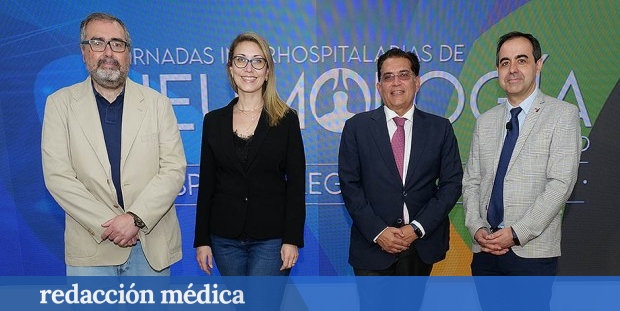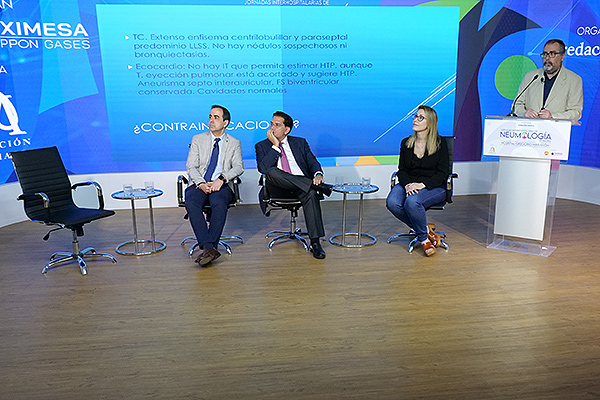Severe COPD volume reduction, ‘effective’

Javier Garcia Lopez, Paula Benedetti, Luis Puente Maest and Javier de Miguel Diez.
The Volume reduction in COPD (COPD) ‘Effective in all variants’. However, it does require a comprehensive study of patients who can benefit from these treatments, as explained by pulmonologists in Gregorio Maranon Hospital Who participated in the new Interhospital conference on pulmonology in Madridorganized by medical writing.
During the meeting, sponsored by Neumomadrid Foundation In cooperation with GSK s Oxymsa Nippon gasesA review of treatment options for patients with severe COPD, whose daily habits are limited, was conducted. He explained that “the patient expresses this great feeling of lack of air and the need to breathe very superficially.” Paola BenedettiDr., a medical specialist in the Respiratory Service of the Gregorio Marañone Hospital, has focused on the basics and indications for these alternatives.
|
Discussion table on volume reduction in severe COPD. |
The main goal, as explained by the expert, is “a little more help” to the patient, that is, Reduce hyperinflation Improve respiratory mechanics and diaphragm muscle function. Also, improving the elastic contraction of the lung, favoring the gas exchange capacity of the remaining lung tissue or reversing the chronic decrease in the supply of tissues with oxygen.
Like all treatment, Benedetti warned, Size reduction has indications and contraindications. The first is that he is a patient with severe emphysema, with “severe” shortness of breath or who meets certain functional criteria. Among the contraindications, on the other hand, we find the presence of bronchiectasis or cancer as well Continuation of the tobacco habit or treatment with prednisone, among others.
The specialist explained that the types of lung volume reduction Valves for acute emphysema with intact incisionsAnd steam in acute emphysema with attached fissures.
One of the primary advantages of valves, the pulmonologist emphasized, is that they are reversible, while steam is “not a reversible option.” At this point, the expert indicated the speed with which this technique is being applied, not the exception to it Possible complications such as shortness of breath, fever or severe pneumonia.
“An essential thing is Careful selection of patientsthe main candidate to refer to these treatments, “notes the specialist, who emphasized that it is necessary”Offer benefit over risk. Another important aspect, he added, “is that there is no age limit and does not interfere with lung transplantation.”
|
Javier García-López, Paola Benedetti during the Inter-Hospital Conference on Pulmonology. |
The experience of cashew nuts in reducing volume in chronic obstructive pulmonary disease
On the table, runs it Luis Puente MaestoHead of the Department of Pulmonology; s Javier de Miguel DiezHead of the Respiratory Service Division. I also intervened Javier Garcia Lopezwho is also the center’s chief of pulmonology services, which chronicled the hospital’s experience with this technology through a clinical case that demonstrated how the specialists worked.
In this case a 71-year-old woman, a former smoker, with a Long-term chronic obstructive pulmonary disease And that he has had two incomes in the past three years. With her, and with any patient, “the potential causes of exclusion must be carefully evaluated,” Garcia explained, emphasizing that “The patient must know the risks before deciding whether to seek treatment“.
After evaluating a file Emphysema via computed tomographyAn echocardiogram, which cannot be evaluated, is performed Pulmonary arterial hypertension Very concretely, the specialist recalls. At this point, he highlights that one of the contraindications, pulmonary hypertension, is the only one available to the patient, so “you have to go further and have a catheterization”, as pulmonologists assure it is neither severe nor moderate, so you can continue with treatment .
“Knowing that it’s a filter, we have to choose how we handle it: whether with valves or steam,” says the specialist. “We always prefer valves because they are reversible in case of complications,” he adds. The patient, remember, was laid Three valves four millimeters. All this just three months after he went to counseling. He remembers that after four days without immediate complications, he was discharged from the hospital. However, ten days after discharge, the patient went to the emergency department referring to a Source That after conducting a study, it was confirmed that it was LSD . atelectasisAlthough his shortness of breath improved.
Since 2015, the specialist noted, The hospital treated 21 patients through coils, valves and steam; With subjective improvement in 80 percent of patients, even after 5 years. However, these procedures “are not free,” Garcia emphasized, so they are associated with risks. In the hospital experience, there was a case of pneumothorax, a massive hemoptysis patient And three patients with serious infections. However, the pulmonologist stressed that “volume reduction is effective in all of its variants,” noting the need for a “comprehensive study” of each case because they are very fragile patients.

Javier de Miguel Diez, Luis Puente Maisto, Paula Benedetti and Javier Garcia Lopez. |
Although it may contain statements, statements, or notes from health institutions or professionals, the information in medical writing is edited and prepared by journalists. We recommend the reader to consult a health professional for any health-related questions.

“Award-winning zombie scholar. Music practitioner. Food expert. Troublemaker.”


/cloudfront-eu-central-1.images.arcpublishing.com/prisa/AHVYMMDSTZDTDBFNZ3LMFUOKNE.jpg)








